
Rods, Reels & Tackle
At Bass Pro Shops and Cabela’s, we believe that the more you know about your equipment, the better you’ll use it to your advantage. Thankfully, we don’t just sell the best rods, reels, and tackle for ice fishing—we use them too! Read below for the lowdown on all the latest fishing gear.
How to Select the Right Ice Fishing Rod
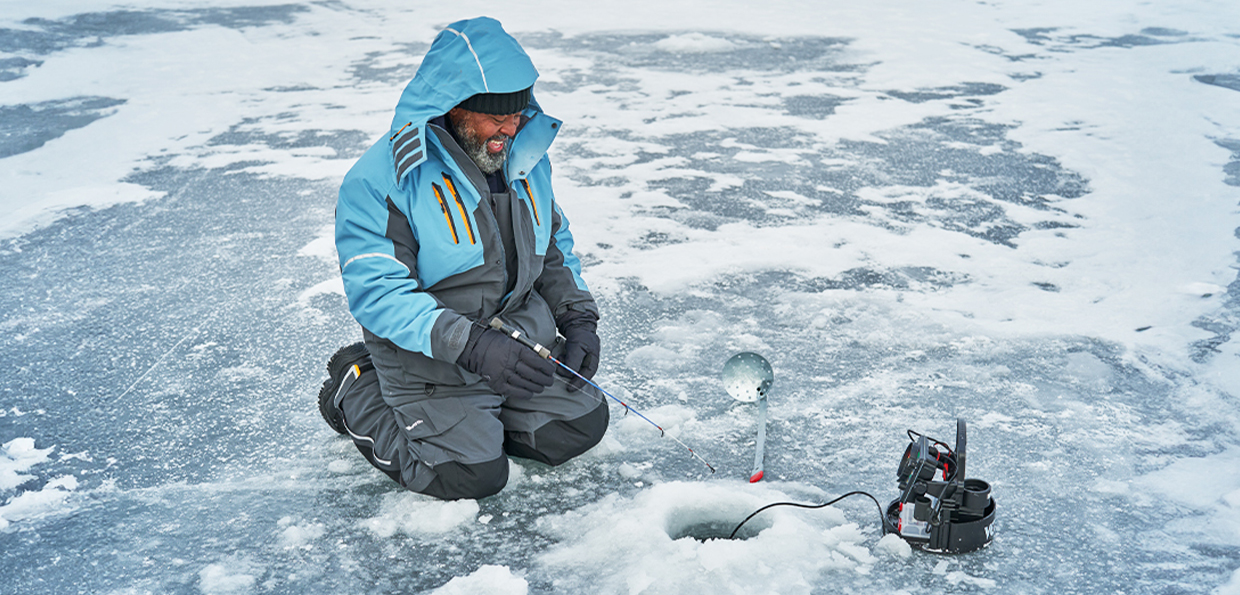
Like open-water rods, ice rods are designed with many different lengths and actions.
Each variation has its ideal application, depending on where you are fishing, the species you are after, and the lures you are utilizing.
- Lake Trout and Pike anglers need Medium Heavy to Heavy action rods with ample backbone to drive a hook home and keep tension on those hard-fighting, fast-running fish.
- Anglers fishing inside small shelters prefer shorter rods (23" - 28"). It is easy to maneuverer in close quarters.
Active anglers prowling the ice prefer longer rods (28" - 32"), for increased hookset power, longer strokes while actively jigging and for a consistent tension while fighting fish.
- Most anglers prefer Ultra Light to Medium Light rods for trout/panfish with small tackle. They allow the angler to feel the weight of the lure or lack thereof when a small fish lifts on a suspended bait. Lighter rods allow anglers to see bites before the fish has had an opportunity to feel anything on the other side.
- Walleye anglers prefer Medium Light to Medium Heavy rods depending on the size of the fish they intent to catch and the lures they are using to target them.
Shallower water, smaller fish and lighter lures warrant lighter rods, while deeper water, larger fish and heavier lures require heavy rods.

4 Must-Know Ice Fishing Knots
Master the art of ice fishing knots with Bass Pro Shops and Cabela’s Pro Staff, Darren McConnachie.

Ice Fishing Knots: Strengths and Uses
Learn the strengths and uses of the Fisherman’s knot, Albright knot, Palomar knot and Uni-to-Uni knot. Make informed decisions to never miss a catch this season!
Fisherman’s Knot
Other Names
Improved Clinch Knot, Angler’s Knot, English Knot
Strengths
- One of the Strongest knots that can retain up to 95% of line strength
- Easy to tie
- Extremely dependable
- Suitable for various fishing lines
- Multispecies knot.
Uses
- Attaches hooks and swivels
- Good to use on braided, and monofilament lines
- Best used for artificial lures
- Tying your line directly to your terminal tackle or lures
Albright Knot
Other Names
Alberto Knot, Modified Albright Knot, and the Improved Albright Knot
Strengths
- Reliable, compact, and versatile
- Reduces the chances of snagging and hindering casting performance
- Suitable for connecting both the lines of different materials and diameters
- Has a low profile when providing a secure connection
Uses
- Usually used in combination with a Uni knot for best-secured connection
- Used to take the main braided line and attach it to the fluorocarbon leader
- To attach hooks, swivels, and lures
- Used for carp fishing and jigging
Palomar Knot
Other Names
Indian Knot
Strengths
- Easy and quick to tie
- Effective to use for fishing lines up to 20-pound test
- Maintains full line strength, clinches tight
- It can change the angle on your jig
Uses
- Secures hooks, swivels, and lures
- This knot is used with fluorocarbon, monofilament, and braided lines
- Tying drop shot rigs
- Fly, carp, catfish, tuna, musky, surf, and bass fishing
Uni-to-Uni Knot
Other Names
Grinner Knot, Double Uni Knot and Uni Knot, Duncan Knot
Strengths
- Strong and versatile as it preserves up to 90% of line strength
- Does not slip under strain
- Easy to attach fishing lines to the spool of a reel
- Can join lines of different diameters
Uses
- Secures hooks, snaps, and lures for larger game fish
- Tying on spinners and jigs
- To tie the main braided line to the fluorocarbon leader
A Guide to Choosing the Right Ice Fishing Line
What’s the best line for ice fishing? The cold weather lines differ from open-water fishing lines. When choosing an ice-fishing line consider pricing, visibility, durability, and availability.
Sensitivity: To detect fish while ice fishing, keep a straight line between the rod tip and the jig or lure for the highest sensitivity.
Line Memory: Fishing lines have coils due to manufacturing and storage. Line memory refers to how long the line keeps these coils. Low-memory ice fishing lines are ideal as they reduce slack and increase sensitivity.
Tip: To reduce coils, use heavier jigs or a lighter pound line to tighten the line.
Friction Strength: The bottoms of the ice holes are sharp, and a hooked fish can damage the line while grinding along these ice edges. Have proper line strength and use an ice stopper bobber to decrease line breaks.
Heavier Tungsten: Tungsten jigs are heavier and denser than the same-sized lead jigs. It allows you to use smaller jig heads for those smaller fish. Tungsten jigs reach deeper water columns and help reduce slacks/coils.
Types of Ice Fishing Lines
Using a top-quality line is essential for ice fishing.
Fluorocarbon Fishing Line
- Low visibility
- Sinks faster
- High memory (increase in coils)
- Low stretch
- Higher cost
- Abrasion resistant
Monofilament Fishing Line
- Medium visibility
- Sinks slower
- Low memory (reduces coils)
- High stretch
- Lower cost
- Easy to manage in colder temperatures
Copolymer Fishing Line
- Low visibility
- Small to middle-diameter
- Low to middle memory
- Middle stretch
- Higher cost
- Abrasion resistant
Choosing The Right Tackle
There’s more to ice fishing than dropping a line in the water. Let us help you choose the right tackle to increase your chances of striking big out on the ice. Modern lures are designed to play off the key senses that gamefish use for hunting: sight, sound, movement, and smell.
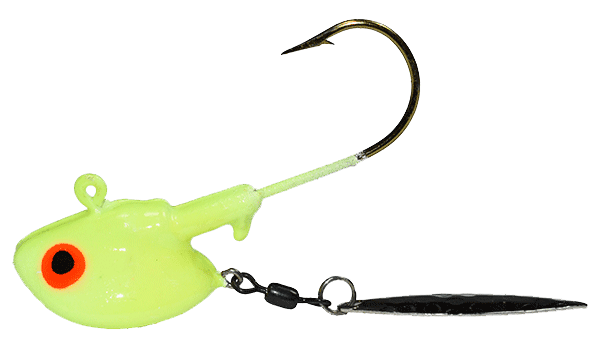
Jigs
Jigs are the easiest and most basic lure to use when ice fishing. They are usually tipped with either plastic bait, frozen minnow, or live minnow. Jigs are often either lightly jigged or allowed to sit inactive as a “deadstick” rod. Jigs come in various sizes, and colours, and can include rattles or blades for increased attraction.
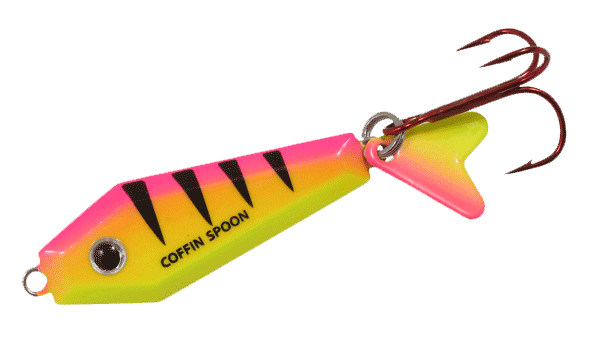
Spoons
Spoons tend to be worked more aggressively than jigs. The rate of fall and the amount of flash is influenced by the size and weight of the spoon. Thinner and lighter spoons present much slower when jigged, while heavier and narrower spoons will dart and fall much faster. Spoons can also be used tipped with a variety of baits as well, including smaller chunks of frozen minnows.
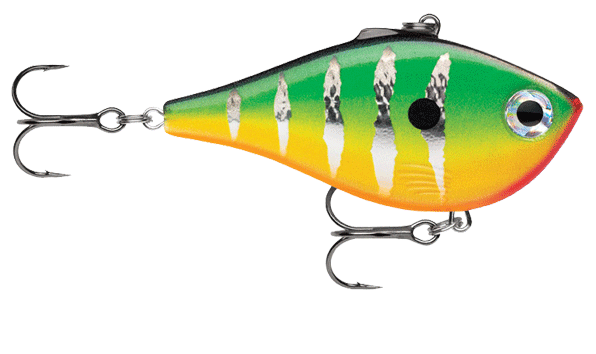
Lipless Crankbait
Lipless crankbaits are one of the most active and aggressive presentations through the ice. Their popularity increased over the years as searching baits to attract fish. Their powerful rattles and horizontal darting motions entice fish to actively search for them. It is not necessary to tip a rattle bait with live or frozen bait as it ruins the lure's action. Some anglers like adding scents to entice fish to bite.
Using Jawjackers and Tip-Ups
 A JawJacker Hook Setter is the perfect ice rod holder for an angler’s secondary line. Use it with a heavier action rod that can be fully loaded up while in the holder. Set the release tension knob (wingnut) to hold slightly more than the weight of your lure, drop your hook to the desired depth, and arm your device.
A JawJacker Hook Setter is the perfect ice rod holder for an angler’s secondary line. Use it with a heavier action rod that can be fully loaded up while in the holder. Set the release tension knob (wingnut) to hold slightly more than the weight of your lure, drop your hook to the desired depth, and arm your device.
Ensure your line is in the trigger so the JawJacker will snap into action at the slightest bite and set the hook for you. Get your rod as quickly as possible when the JawJacker is tripped and starts reeling in your catch!
To learn the true fish-catching potential of your secondary line, pair the Hook Setter with the battery-operated Jigging Base and select the jigging pattern wheel that best compliments your lure of choice.
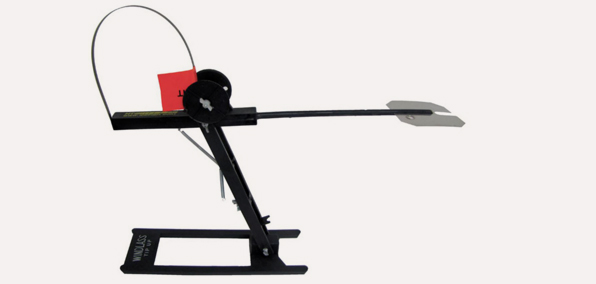 Tip-ups are the most cost-effective way to target big fish, and they demand less effort on the angler’s behalf. Most tip-ups function the same way. A tensionless spool of line is set at a desired depth by a spring-loaded flag that will stand up when a fish pulls out the line. Fish are fought by pulling up line by hand while using a light grip to function as your ‘drag.’ This allows the fish to run without the hook pulling free from its mouth.
Tip-ups are the most cost-effective way to target big fish, and they demand less effort on the angler’s behalf. Most tip-ups function the same way. A tensionless spool of line is set at a desired depth by a spring-loaded flag that will stand up when a fish pulls out the line. Fish are fought by pulling up line by hand while using a light grip to function as your ‘drag.’ This allows the fish to run without the hook pulling free from its mouth.
In extremely cold conditions, anglers typically prefer circular models that completely cover and insulate the hole, or they utilize devices like the ripple-puck in conjunction with a conventional tip-up to prevent the hole from freezing over.
Self-jigging tip-ups like the HT Windlass have shown to be quite effective for anglers fishing in waterbodies where predators prefer to hit moving targets. These tip-ups capture wind gusts to give the bait movement.
Rod/Tip-Up hybrids like the iFish Pro Tip-Up or the HT Ice Rigger Tip-Up allow anglers to utilize their rod and reel on free-spool in conjunction with a flag system for indicating when a fish is running with its bait. These are ideal solutions for people who are not comfortable hand-lining or would like to utilize their favourite rods and reels.
How to Use Tip-Ups
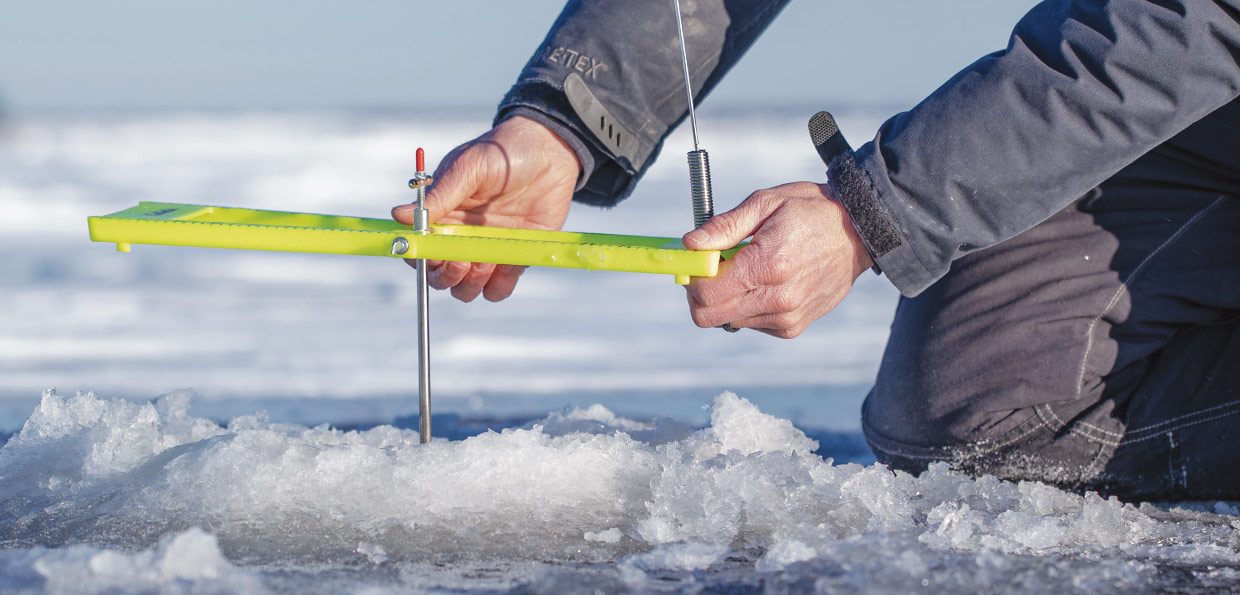
8 Easy Steps to Set Up a Tip-Up
- Location: Use contour maps or mapping tools to find drop-offs, find points and submerged humps that will concentrate the fish.
Note: Check your provincial guidelines for the allowance of tip-ups. - Drill Holes in The Ice: Each tip-up requires its hole drilled in the ice as it rests on top of the hole. Most anglers use an 8-inch auger for tip-ups since you can fit everything from northern pike to perch.
- Spool Your Line: Choose the right line to succeed in ice fishing. Avoid kinking by using flexible lines like Dacron. Add electrical tape to prevent slippage. Use a 20–30-pound test for bass and heavier line for salmon or lake trout.
- Attach a Swivel & Leader: Attach a barrel swivel to prevent line twisting. Use a braided steel leader for fish with sharp teeth like pickerel or pike.
- Tie on The Hook: Choosing a hook depends on your target. For instance, a bluegill or a crappie can be caught with an Aberdeen hook. You can unhook the fish easily when brought to the surface with a lengthier hook of size six or eight.
Pro Tip: For walleye, choose a size between a four or a six. For pike, go with a size 2/0 to 6/0.
- Attach Split Shot: A split shot is a little ball that keeps the bait weighed down. Attach the split shot to the leader and keep it far enough (4 to 5 inches) from the bait to sink it. If the bait is down, avoid adding any more split shots.
- Drop the Line: For any tip-up, the flag should be in the down position to indicate the catch. Pull the desired line length from the spool and drop it into the hole. Place the tip-up right above the ice hole. If there is wind, make sure to place it in a direction that the tip-up is not affected.
Note: A few provinces have regulations about how many holes you can have lines in at once. - Pull in Your Catch: Wait a bit after the flag pops up, then gently take up the line to feel if the fish is still on the bait. Use gloves to avoid line cuts and reel in the fish slowly.
Playing Off the Senses
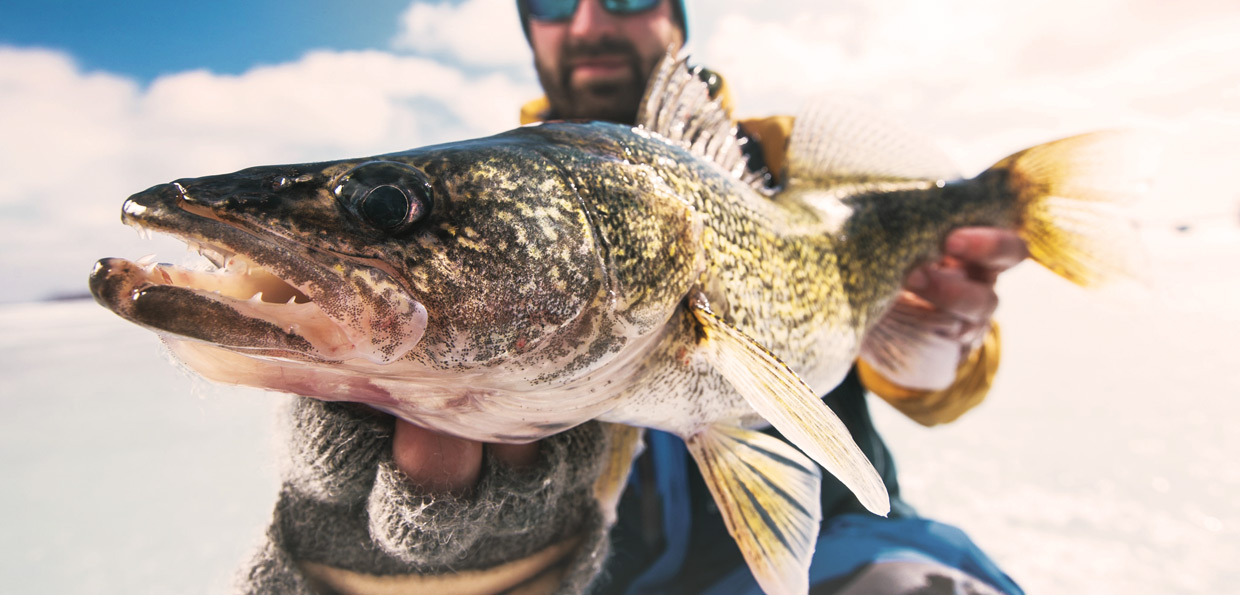
Sight
Light and visibility can become very low during hard water season. Many lure designers have produced models that incorporate lightsticks into lures to combat this issue. These lightsticks make it extremely easy for fish to see at considerable distances.
Sound
Predatory fish can pick up small sounds and vibrations from great distances using their lateral line organs. Many different spoons and jigs have rattles incorporated into them to call fish when they are too far away to physically see the lure. Lipless crankbaits provide the most noise and vibration and mimic quick-darting actions to attract hungry fish.
Movement
Most lures are designed to replicate the movement of a game fish’s natural forage. Severe movements in the water column are picked up by fish’s lateral lines and any activity seen as a ‘fleeing’ or ‘retreating’ motion can be effective at triggering strikes from both active and lethargic fish. Glide baits, flutter spoons and blade baits are extremely effective lures that play heavily on a predatory fish’s fixation with movement.
Smell
Many anglers prefer to tip their lures with fresh or frozen bait. However, advancements in plastic bait technology have made many non-organic baits equally as effective, while also possessing greater longevity.


